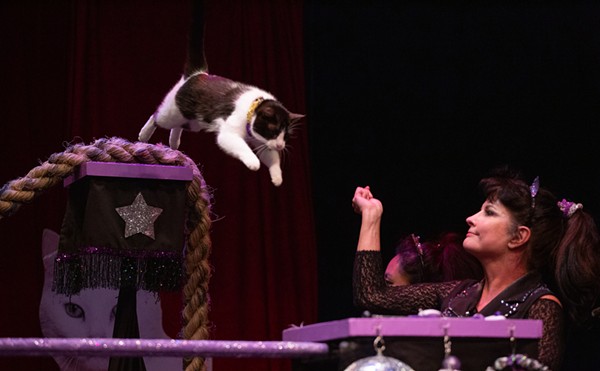Aesthetes of a high-minded bent might have you believe that classical music is an abstract thing of the spirit. Truth is, to make any kind of music — and we have this on no less an authority than Mick Jagger — you gotta move.
When the young Mexican conductor Alondra de la Parra first appeared with the San Antonio Symphony last October, one of many remarkable aspects of her performance was the way she conducted with her entire body, as though the music were flowing through her. Plenty of that kind of movement is likely when she returns this weekend to conduct the orchestra in a program suffused with dance feeling. She opens with the “Brazilian Fanfare,” a whirlwind tour of that country’s folk traditions by Clarice Assad, daughter of the renowned guitarist and composer Sérgio Assad. The closer is Ludwig van Beethoven’s “Symphony No. 7,” sometimes called the “Dance Symphony” because the life of this celebratory music is in its dance-like rhythms. In between come Claude Debussy’s “Prelude to the Afternoon of a Faun,” which became a notably randy ballet by Nijinsky and is some of the sexiest music ever written; and Serge Prokofiev’s “Violin Concerto No. 2,” whose third movement sounds much like a rustic dance.
The soloist in the Prokofiev is American violinist Jennifer Koh, a champion of new music and a performer who has won praise for her intensity and intelligence. She plays (on loan) a Stradivarius that was previously owned by the great Belgian violinist Arthur Grumiaux.
Born in New York City but reared in Mexico, de la Parra returned to the city of her birth in 2000 to study piano and conducting at the Manhattan School of Music. Three years later, at age 23, she founded the Philharmonic Orchestra of the Americas as a showcase for soloists and composers from Latin America. Like her, it is located in New York.
“I’m based in New York, but sometimes I think I’m based on the plane,” de la Parra said by phone last week from Columbus, Ohio, where she was preparing for concerts with that city’s symphony orchestra. She had just finished a gig in Phoenix. Her San Francisco Symphony debut is scheduled for November.
De la Parra attributes her whole-body conducting to her training at Manhattan.
“My teacher, Kenneth Kiesler, a wonderful teacher and conductor, always taught me to be the music, let the music resonate through my body,” de la Parra said.
“I did study ballet for many years,” she added, but she also noted a crucial difference between dancing to music and conducting it. “The big difference between dancing and conducting is timing.” As a conductor, her movements respond to the score and always have to occur just before the music happens.
At age 28 — she turns 29 this Halloween — de la Parra is still very young, as widely traveled conductors go, and is still essaying much of the standard repertoire for the first time. Astonishingly, that was the case last year when she led the San Antonio Symphony in a compelling account of Tchaikovsky’s “Symphony No. 5.”
“There’s a lot that is my first time, but that doesn’t mean I haven’t been studying it for many years,” she said.
If that comment sounds slightly defensive, de la Parra has good reason to stress her experience over her youth: She is one of seven conductors the symphony is bringing back this season for a second look as it continues searching for a music director. De la Parra designed this weekend’s program to cover a wide stylistic gamut.
“I wanted a lot of contrast in the program — different sounds, different textures,” de la Parra said.
The Prokofiev concerto — the soloist’s choice — represents the European modernist mainstream and is both lyrical and biting. The Beethoven symphony, which also was on de la Parra’s Columbus program last weekend, is a standard classical work that meets American Bandstand criteria: It has a good beat and is easy to dance to. The Debussy — “one of my favorite pieces,” de la Parra said — is harmonically and rhythmically elusive, an 1894 work that ushered in the modernist period and that stands nearly at the opposite stylistic pole from the Beethoven.
Regarding Assad’s “Brazilian Fanfare,” de la Parra said, “I know Clarice personally. I think she’s a really promising young composer. I wanted to program something from the Americas that wasn’t from Mexico.” (She opened her San Antonio program last year with “Danzón No. 2” by Mexican composer Arturo Márquez.)
“I did grow up listening to a lot of Brazilian music,” de la Parra added. “I’ve been to Brazil; I have a lot of Brazilian friends.” But, despite the Latin-American emphasis of her New York orchestra, she refuses to be stereotyped. “I feel an affinity with almost every music.”•















